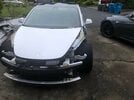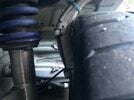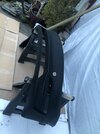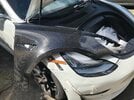The C8 for example, sidewall to sidewall is 76-3/4” and 76-1/4” although track width is 64.9” & 62.4”The 991.2 GT3 is 30mm wider in the rear. Track width isnt a limitation for stagger.
Welcome to Tesla Motors Club
Discuss Tesla's Model S, Model 3, Model X, Model Y, Cybertruck, Roadster and More.
Register
Install the app
How to install the app on iOS
You can install our site as a web app on your iOS device by utilizing the Add to Home Screen feature in Safari. Please see this thread for more details on this.
Note: This feature may not be available in some browsers.
-
Want to remove ads? Register an account and login to see fewer ads, and become a Supporting Member to remove almost all ads.
You are using an out of date browser. It may not display this or other websites correctly.
You should upgrade or use an alternative browser.
You should upgrade or use an alternative browser.
The quest for wider wheels and tires, 295, 305 and beyond...
- Thread starter Davidss2
- Start date
Lindenwood
Active Member
Obviously track width is a factor, but consider it more a secondary metric. You could add 25mm spacers to just the rear axle of a GT3–changing nothing but track width—and it wouldn’t significantly affect overall course performance.
gearchruncher
Well-Known Member
And for example, the track width on a 991.2 GTS is 3mm wider in the rear, but the tires are 60mm wider in the rear, so the rear sidewall to sidewall is 66mm wider overall. So no, they are not all the same just because a few cars are.The C8 for example, sidewall to sidewall is 76-3/4” and 76-1/4” although track width is 64.9” & 62.4”
I mean, widebodies are a thing on great handling cars, it's something Porsche literally does to their quicker cars.
Last edited:
Lindenwood
Active Member
@buckets0fun Please elucidate me if you degree so vehemently.Obviously track width is a factor, but consider it more a secondary metric. You could add 25mm spacers to just the rear axle of a GT3–changing nothing but track width—and it wouldn’t significantly affect overall course performance.
The Z06 is 66.3f and 66.1r with 275/345.The C8 for example, sidewall to sidewall is 76-3/4” and 76-1/4” although track width is 64.9” & 62.4”
Lotus Elise is 2" wider rear track width.
S550 mustang is 2.5" wider rear track width.
991.2 911turbo is 0.5" wider rear track width and 70mm in tire split.
We're just saying, total width split isn't all that important.
Lindenwood
Active Member
Btw, is this a 315/35R18 (26.7”) or 315/30R18 (25.4”)?18”X11” +25 with 315 Nfera5 . 15mm spacers on hypergrams seems to fit. I was gonna add 1/4 panels before driving but test fit one and it had plenty of inside clearance. Outside almost seemed like it could work as is
18”X11” +40 w/315 is great in the rear
And confirm you mean the 18x11+40 wheels, using 15mm front spacers?
315/30. I ran them in a wet Autocross on Sunday. Pretty fast even in rain surprisingly! Saturday I borrowed a ‘22 STI & got to time too! I haven’t driven a stick in sooo long! Got my S in ‘12& have been left foot braking since. First corner I hit clutch instead of brakes. Shocked I ended in first.Btw, is this a 315/35R18 (26.7”) or 315/30R18 (25.4”)?
And confirm you mean the 18x11+40 wheels, using 15mm front spacers?
Maybe a couple of credit cards fit between the tire and upright. Perfect
Trying to get my car together for laguna seca optima
Attachments
Last edited:
CKwik240
Member
Every time I stress about rubbing on something, one of you post up a configuration that has the tire so close to the upright. I'm currently on 275/30R20 S007s. I purchased a set of Potenza Sports of the same size and they appear wider. While rotating my current tires, I set them down side by side and it's visually about an inch wider. Granted the width from bead to bead in the relaxed state is probably about an inch wider as well, but it still concerns me. Seeing photos of such tight clearances helps... Lol315/30. I ran them in a wet Autocross on Sunday. Pretty fast even in rain surprisingly! Saturday I borrowed a ‘22 STI & got to time too! I haven’t driven a stick in sooo long! Got my S in ‘12& have been left foot braking since. First corner I hit clutch instead of brakes. Shocked I ended in first.
Maybe a couple of credit cards fit between the tire and upright. Perfect
Trying to get my car together for laguna seca optima
Lindenwood
Active Member
We have all seen the Tire Rack width test (discussed in this thread).
@MasterC17 ’s observations posted in his 200tw tire assessment (linked below) corroborated Tire Rack’s, where he assessed a 275 was best for a 10.5 and, as an example, a 255 would likely perform better in a 9.5 than a 275 would. (He specifically cites edge rollover, so I am not 100% sure he isn’t speaking more to uneven wear than outright pace, but I presume edge rollover drives uneven loading across the tread, or higher tire pressures to compensate, either of which would likely reduce pace).
Expanding the Tire Rack comments that a 245-width tire on a 10” wheel would have been faster, I added a hypothetical extrapolation and some best-fit lines.
The example time reductions are simply the result of 1% faster * 30 seconds, and 1.5% faster * 30 seconds, relative to their “control” times, which happen to line up with the 225 on 7” data.
Separately, I included the ratio of nominal wheel width to measured tread width for the 225/9, 245/9, and 245/10 combos.

Question: for those running 295s and 305s on 10.5” wheels, with as low as 0.95” “stretch” ratios, have you observed or assessed you are faster than a 275 on the same wheel? (With otherwise as close to the same tire model as possible).
As noted, the most pinched 225 was still faster than the most stretched 215, so it’s certainly possible even a 305 on a within-spec 10.5 is still faster. Still, I do wonder if there could be more gains with 11 or 11.5” wheels with 285s, or even 12” wheels and 295s or 305s. (A mild widebody would likely be necessary at the offsets required to fit over the knuckle, unless the diameters are very undersized).
Interestingly, these 245s on 2850lb BRZs have about the same total tread surface area as a ~305 tire on our 4100lb cars. That is not accounting for the additional tire workload of nearly doubling the HP/Weight with an M3P, so even 315s or 325s could show worthy gains with an appropriately-wide wheel (under a widebody).
(@MasterC17 ’s 200tw tire assessment:
2023 200TW Tire Assessment )
@MasterC17 ’s observations posted in his 200tw tire assessment (linked below) corroborated Tire Rack’s, where he assessed a 275 was best for a 10.5 and, as an example, a 255 would likely perform better in a 9.5 than a 275 would. (He specifically cites edge rollover, so I am not 100% sure he isn’t speaking more to uneven wear than outright pace, but I presume edge rollover drives uneven loading across the tread, or higher tire pressures to compensate, either of which would likely reduce pace).
Expanding the Tire Rack comments that a 245-width tire on a 10” wheel would have been faster, I added a hypothetical extrapolation and some best-fit lines.
The example time reductions are simply the result of 1% faster * 30 seconds, and 1.5% faster * 30 seconds, relative to their “control” times, which happen to line up with the 225 on 7” data.
Separately, I included the ratio of nominal wheel width to measured tread width for the 225/9, 245/9, and 245/10 combos.
Question: for those running 295s and 305s on 10.5” wheels, with as low as 0.95” “stretch” ratios, have you observed or assessed you are faster than a 275 on the same wheel? (With otherwise as close to the same tire model as possible).
As noted, the most pinched 225 was still faster than the most stretched 215, so it’s certainly possible even a 305 on a within-spec 10.5 is still faster. Still, I do wonder if there could be more gains with 11 or 11.5” wheels with 285s, or even 12” wheels and 295s or 305s. (A mild widebody would likely be necessary at the offsets required to fit over the knuckle, unless the diameters are very undersized).
Interestingly, these 245s on 2850lb BRZs have about the same total tread surface area as a ~305 tire on our 4100lb cars. That is not accounting for the additional tire workload of nearly doubling the HP/Weight with an M3P, so even 315s or 325s could show worthy gains with an appropriately-wide wheel (under a widebody).
(@MasterC17 ’s 200tw tire assessment:
2023 200TW Tire Assessment )
Last edited:
Lindenwood
Active Member
Oops. I meant total TTSA per pound! The model 3 is about 40-45% heavier, inherently requiring more rubber in the ground to avoid overwhelming the tires. Separately, the greater power-to-weight of the Model 3 puts even more stress on the rubber, potentially justifying even more TTSA without having to compensate with harder compounds.Interestingly, these 245s on 2850lb BRZs have about the same total tread surface area as a ~305 tire on our 4100lb cars. That is not accounting for the additional tire workload of nearly doubling the HP/Weight with an M3P, so even 315s or 325s could show worthy gains with an appropriately-wide wheel (under a widebody).
gearchruncher
Well-Known Member
Remember - wider tires do not put more tread on the ground. Only lower pressure does that. Wider tires change the contact patch shape.
But as in all things tires, it's complicated.
But as in all things tires, it's complicated.
Lindenwood
Active Member
(Tracking! I didn’t specifically say it, but yes my assumption is one runs proportionally-lower pressures with the wider tires. I alluded to it in the earlier comments that if one runs a wider tire, but has to bump up pressures to compensate for an under-supported sidewall (assuming appropriate camber), they lose the benefits of the wider tire.)Remember - wider tires do not put more tread on the ground. Only lower pressure does that. Wider tires change the contact patch shape.
But as in all things tires, it's complicated.
Have you made any more specific observations or assessments related to my question on running >275s on a 10.5? I know you said you were faster on your 295 RE71RS than 275 A052s, but do you assess that is due to the more appropriate compound? Further, do you have any hint that you would be even faster on an 11.5 or 12” wheel?
Last edited:
Wider tire needs less pressure for the same load. Always.(Tracking! I didn’t specifically say it, but yes my assumption is one runs proportionally-lower pressures with the wider tires. I alluded to it in the earlier comments that if one runs a wider tire, but has to bump up pressures to compensate for an under-supported sidewall (assuming appropriate camber), they lose the benefits of the wider tire.)
Have you made any more specific observations or assessments related to my question on running >275s on a 10.5? I know you said you were faster on your 295 RE71RS than 275 A052s, but do you assess that is due to the more appropriate compound? Further, do you have any hint that you would be even faster on an 11.5 or 12” wheel?
Lindenwood
Active Member
I absolutely understand this reality, never contradicted it, and am not sure why this is the singular focus of all the responses…Wider tire needs less pressure for the same load. Always.
Anyone have actual inputs on my bolded question above?
Extrapolating between different cars is pretty hard. Our wheels/tires are not 40% larger than 17"/25-ish inch rolling diameter tire on the Tirerack's BRZ.
There's only one way to tell - test it on the car you intend to run. Anything else is just guessing.
I would also take Tirerack's results with a grain of salt. They never give us the variance (or better yet actual individual lap times they averaged) to their point estimates, so there's no way to tell if their 1-2% average gains are just noise. They also never adjust anything. Maybe the wider tire needs a bit more camber?
"Wider is better" is the empirical observation from decades of racing data and, personally, I'm not gonna abandon it because of a few not so transparent tests.
If you want better steering response, I'd go with a shorter tire of the same width.
That said, I'm not running 305/30/19 tires again. I *think* to run those safely to avoid front tires slamming into one's stock fenders at full bump while running on some subpar autox lots I really needed to limit compression on my RW Ohlins, which I *think* led to full-load cornering with front bumpstops engaged. Not good for the handling balance. One can go with 1-2" undersized tires, but that can create battery clearance issues under full lateral load if one is already quite lowered.
If you're buying wide fenders + modified uprights, I'd go wider and adjust the rest of the suspension to maximize grip.
There's only one way to tell - test it on the car you intend to run. Anything else is just guessing.
I would also take Tirerack's results with a grain of salt. They never give us the variance (or better yet actual individual lap times they averaged) to their point estimates, so there's no way to tell if their 1-2% average gains are just noise. They also never adjust anything. Maybe the wider tire needs a bit more camber?
"Wider is better" is the empirical observation from decades of racing data and, personally, I'm not gonna abandon it because of a few not so transparent tests.
If you want better steering response, I'd go with a shorter tire of the same width.
That said, I'm not running 305/30/19 tires again. I *think* to run those safely to avoid front tires slamming into one's stock fenders at full bump while running on some subpar autox lots I really needed to limit compression on my RW Ohlins, which I *think* led to full-load cornering with front bumpstops engaged. Not good for the handling balance. One can go with 1-2" undersized tires, but that can create battery clearance issues under full lateral load if one is already quite lowered.
If you're buying wide fenders + modified uprights, I'd go wider and adjust the rest of the suspension to maximize grip.
Lindenwood
Active Member
Thanks for the notes!Extrapolating between different cars is pretty hard. Our wheels/tires are not 40% larger than 17"/25-ish inch rolling diameter tire on the Tirerack's BRZ.
There's only one way to tell - test it on the car you intend to run. Anything else is just guessing.
I would also take Tirerack's results with a grain of salt. They never give us the variance (or better yet actual individual lap times they averaged) to their point estimates, so there's no way to tell if their 1-2% average gains are just noise. They also never adjust anything. Maybe the wider tire needs a bit more camber?
"Wider is better" is the empirical observation from decades of racing data and, personally, I'm not gonna abandon it because of a few not so transparent tests.
If you want better steering response, I'd go with a shorter tire of the same width.
That said, I'm not running 305/30/19 tires again. I *think* to run those safely to avoid front tires slamming into one's stock fenders at full bump while running on some subpar autox lots I really needed to limit compression on my RW Ohlins, which I *think* led to full-load cornering with front bumpstops engaged. Not good for the handling balance. One can go with 1-2" undersized tires, but that can create battery clearance issues under full lateral load if one is already quite lowered.
If you're buying wide fenders + modified uprights, I'd go wider and adjust the rest of the suspension to maximize grip.
I certainly have no question that overall, wider is better for ultimate grip! Still, this Tire Rack test, even if less than perfect (but still better than 99% of internet anecdotes), is far from the only example asserting that best traction requires a sufficiently-wide wheel to support the tread and sidewall. Even in this thread, multiple members have cited that tread width should be 0 to 0.5” less than wheel width, which is not the case for most of the 295 or 305s commonly mounted on 10.5” wheels here.**
**(from, or at least repeated in, this blog:
How to PROPERLY select and size TIRES for PERFORMANCE - Page 2 of 5 - MotoIQ )
I’m just curious if we collectively have enough data to more reasonably conclude that 295s and 305s on 10.5” wheels are generally faster than 275s or 285s. Alternatively, I am curious if we have enough data to support that 295s and 305s would be (even) faster on 11-12” wheels. There are a few decent anecdotes across the web, and in this thread. However, there are 100x as many examples of “I went from a 245 all-season to a 275 race tire and got way faster” or “I run a 315 on my factory 19x9 and Im happy” that are less valuable.
gearchruncher
Well-Known Member
I'd simplify it to this. If you are repeatedly losing AutoX's by a tenth of a second, then get wider tires. If you are hoping they'll gain you a half second, you need to work on the driver.
TBH, if one were to invest tons of time/effort/$$ into research/testing to squeeze the extra 0.1s out of tires, it may still be worth it instead to invest the same resources into seat time/driver education for likely higher payoff. Unless one is already an alien-level autoxer.I'd simplify it to this. If you are repeatedly losing AutoX's by a tenth of a second, then get wider tires. If you are hoping they'll gain you a half second, you need to work on the driver.
Tire testing is prohibitively expensive for amateur sports. If I had the dough to properly test multiple setups while taking the time to adjust my suspension for each, I'd be driving a GT3 anyway
I AM contemplating getting another set of RE71RS's (before my current one wears out) in a 275-285 width for 19x10.5 wheels that I have, but so far my inner scrooge is winning. I should probably spend a grand or two on a decent data acquisition setup instead.
Last edited:
Tirerack also did the same test in 2022 and ended up with the 225->245 change yielding slightly slower laps in the dry. In the 2023 test linked above, the 225->245 move resulted in a hair faster time...Still, this Tire Rack test, even if less than perfect (but still better than 99% of internet anecdotes), is far from the only example asserting that best traction requires a sufficiently-wide wheel to support the tread and sidewall.
Lindenwood
Active Member
The article I referenced actually was the 2022 test, which indeed showed the 225s were fastest with the available rim width. As mentioned, they assessed the 245 would have been fastest if they could have mounted it on a 17x10 wheel on the test vehicles. That is what I highlighted with the additional bar on the graph, and the best-fit lines.Tirerack also did the same test in 2022 and ended up with the 225->245 change yielding slightly slower laps in the dry. In the 2023 test linked above, the 225->245 move resulted in a hair faster time...
The 2023 test was for a longer road course (~105-sec laps versus their smaller ~30s course). I suspect any improvements for the 245s were related to the greater heat tolerance with the larger TTSA.
Overall, I’ve only found the same overall assertions—that a wider wheel for a given tire size is generally better for performance—in their other articles, like this:
Wheels - Always use the widest wheels allowed in your car's class, that fits your car and/or is recommended by the tire manufacturer for your tire size.
…and…
For handling-oriented track & competition fitments, Tire Rack recommends mounting tires on the widest rim width approved by the tire manufacturer.
Last edited:
Similar threads
- Replies
- 17
- Views
- 1K
- Replies
- 5
- Views
- 349
- Replies
- 15
- Views
- 2K






